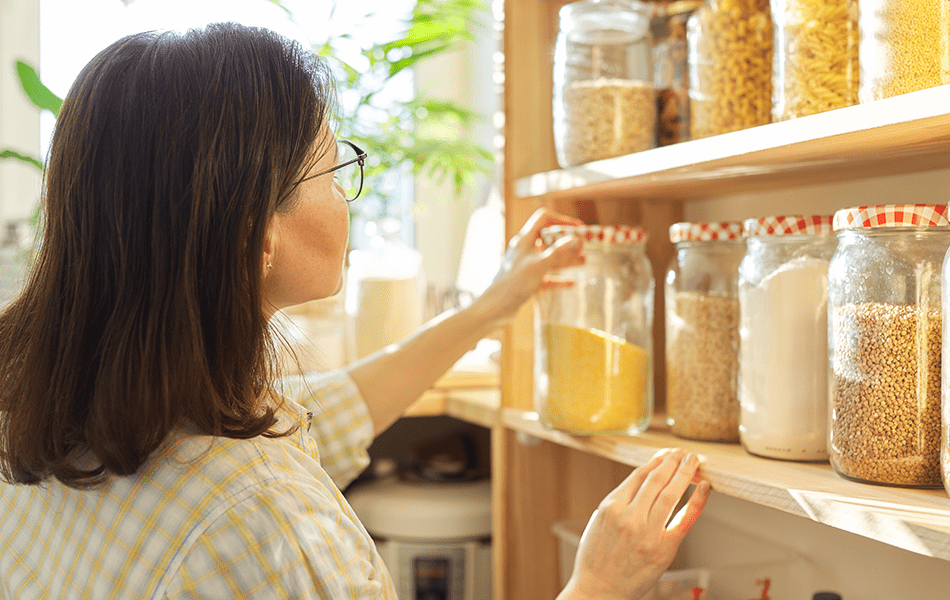When it comes to grocery shopping, it can be overwhelming to decide what to buy, especially if you are on a budget. That is why having a shopping list can come in handy. This list should have all your pantry essentials laid out taking into consideration your storage space, what ingredients you’ll need in the next few weeks, and how you can maximize your visit to the grocery.
In the current economic climate, it’s more important than ever to be efficient in our grocery shopping. With the rising cost of food and household goods, making the most of our money and resources is essential. That’s why having a well-stocked pantry with essential grocery items can help save you time and money in the long run.
We’re going to give you a number of basic grocery list ideas. This is by no means a must-follow for everyone who goes grocery shopping. Some people may have different diets or food requirements. What we will try to do here is help your trip to the grocery be far less stressful than it has any right to be. A good home is not complete unless it has a well-stocked pantry.
How to make the essential grocery list
When it comes to grocery shopping, there are some best practices that we can follow to make the most of our budget. One of the most effective ways to save money is to make a basic grocery list and stick to it. This will help us avoid going nuts on impulse purchases and ensure that we only buy what we need. Additionally, shopping in bulk can save us money over time, as long as we only purchase what we know we’ll use. If done right, you can have your pantry stocked for up to a year ready for whatever recipe you plan on cooking up.
Before we go into specifics, let’s talk about how to properly structure the perfect basic grocery list. Food shopping is something we all do at a certain point. Going into the store and picking out which key ingredient you need for cooking whether it be sauces, condiments, spices, sugar, rice, or whatever it may be, getting pantry essentials can be an enjoyable process if you come prepared.
Make your grocery runs a better experience. Here are some characteristics that make a good basic grocery list:
Organized
A good grocery list should be well-organized, making it easy to find the items you need quickly. You can organize your list by categories, such as dairy, produce, meat, or cleaning materials. This practice makes your trip to the grocery less hectic trying to run around from one corner of the store to the other. You don’t want to be in the frozen goods section trying to buy chicken and then going all the way to the other side for pasta sauces. You can also consider the layout of the store if you’re already familiar with it.
Specific
A good grocery list should be specific about the items you need. Instead of writing “vegetables,” list the specific types of vegetables you need, such as broccoli, carrots, and spinach. This specificity can help you avoid missing items or purchasing the wrong items. Or better yet, this can help you save time by trying to guess what you meant when you initially wrote the items on the list. Specify as much as you can including brand, measurements, and quantity when necessary.
Prioritized
A good grocery list should have priority, with the most important items at the top of the list. This can help ensure that you get the most essential items first, which can be especially helpful if you’re short on time. Maybe you’re looking to purchase something that has been high in demand at that particular time so better to get on it fast before another shopper (remember when tissues and alcohol were always sold out during 2020?). A common practice is to visit the frozen foods area and order what you need to have packaged already and come back to pick it up once you have gone through your shopping list.
Flexible
A good grocery list should be flexible enough to accommodate changes. You can’t always be assured that your local grocery store will have everything you need. You may find that some food items are out of stock or that you forgot to include something on your list. Being flexible can help you adjust your list on the fly and avoid missing important items.
What is on a pantry essentials list?
You now know how to structure a basic grocery list, now is to fill it up to make sure you have every pantry essential. Whether you have to cook for a quick breakfast, stock up on healthy snacks, or look for recipes for a quick dinner meal, knowing what items you need to get before walking into the grocery will make your trip so much more productive.
A good basic grocery list should include food items that are versatile, healthy, and can be used in a variety of recipes. Here are some essential items that you may want to consider including on your basic grocery list:
1. Fresh produce
Fruits and vegetables are an important part of a healthy diet, so it’s a good idea to include a variety of fresh produce on your food list. Consider items like apples, bananas, oranges, carrots, broccoli, spinach, and tomatoes. A fresh fruit a day keeps the doctor away. Fresh produce is packed with vitamins, minerals, and other important nutrients that are essential for good health. Fresh produce is often available seasonally, which means that you can take advantage of the freshest and most flavorful produce during different times of the year. If you’re feeling up to it, you can even include frozen fruit or dried fruit for easy snacking and storage.
2. Protein sources
Protein is also an important part of a healthy diet, so make sure to include some sources of protein on your shopping list. Consider items like chicken breasts, eggs, red meat, black beans, tofu, and nuts. Protein helps to build and repair tissues, including muscles, bones, and organs. It is also necessary for the production of enzymes, hormones, and other important molecules in your body. In addition, protein can help to keep you feeling full and satisfied after a meal, which can help to reduce the likelihood of overeating and can support weight management goals. Research also suggests that consuming an adequate amount of protein may help to improve muscle strength, particularly as you age.
3. Grains and bread
Grains and bread are versatile food items that can be used in a variety of recipes. Grains and bread are often relatively inexpensive, which makes them a cost-effective way to add calories and nutrition to your diet. They are a good source of carbohydrates, which provide your body with energy. Consider items like brown rice, pasta, whole-grain bread, and pancakes. Be careful when storing bread however as it usually doesn’t last as long as other food products. Make sure to consume them within the week of your purchase for the best quality. For Filipinos, rice is of course, always a must-have.
4. Dairy products
Dairy products like milk, cheese, and yogurt are good sources of calcium, which is important for building and maintaining strong bones. They’re perfect for cooking up complete breakfast foods. When selecting dairy products for your grocery list, aim for low-fat or fat-free options to reduce your intake of saturated fat and calories. If you are lactose intolerant or have a dairy allergy, there are also a variety of non-dairy milk and yogurt alternatives available, such as soy milk, almond milk, and coconut milk yogurt. These options can provide similar nutrition benefits to dairy products, but without the lactose or dairy protein that can cause digestive issues for some people.
5. Canned and frozen goods
Purchasing canned goods and frozen products are great ways to stock up on essentials that have a longer shelf life. Consider items like canned meals, pre-made sauces, canned tomatoes, frozen fruit, and frozen meat or seafood. You’ll never know when you’re gonna need a quick meal. However, some of these can contain a number of food preservatives that may be detrimental to your health if you don’t regulate what you eat but there’s no denying just how much of a versatile ingredient most of them are. Having a good stock of frozen and canned food products will allow you to cook a number of dishes no matter how simple or extensive those recipes are.
6. Condiments
A good meal can always be made better with the right sauces. Condiments can add flavor and variety to your meals. The basics include simple tomato sauce, hot sauce, ketchup, mustard, maple syrup, and soy sauce. If we’re just talking about vinegar alone, there is apple cider vinegar, red wine vinegar, white wine vinegar, and balsamic vinegar. When selecting what to get for your essential grocery list, look for healthy oils like olive oil or canola oil. Additionally, consider buying in bulk or purchasing larger measurements of frequently used condiments to save money in the long run.
7. Spices
Much like condiments, spices can add flavor and nutrition to your meals. However, it can do this without adding a lot of extra calories or unhealthy fats. Spices are derived from plant sources, such as seeds, roots, and bark, and are often rich in antioxidants, vitamins, and minerals. Essential spices to have on your shopping list include sesame seeds, garlic powder, curry powder, red pepper flakes, stock cubes, dried herbs, kosher salt, sugar, and pepper. Consider stocking your pantry with a variety of spices, such as cinnamon, cumin, paprika, garam masala, turmeric, and chili powder, and experiment with different flavor combinations to keep your meals interesting and enjoyable.
8. Snacks
Food shopping is not complete unless you have a snack run included in your grocery list. Snacks can help keep you fueled throughout the day. Pick out easy foods to munch like nuts, dried fruits, chocolate chips, popcorn, and potato chips. Sometimes, you just don’t want to worry about cooking something up or looking at a recipe to settle your hunger. If your pantry is well-stocked with snacks, you can have something to eat at any given moment.
9. Beverages
While water is a must-have every day, sometimes you really just need some more flavor. Starting the day with a cup of tea or coffee and chugging on a refreshing fruit juice on a hot afternoon is always a great idea. Aside from fueling yourself up with food, staying hydrated is equally as important. Feeling a bit more fancy? Why not stock up on some wine bottles to fill in the mini bar at your pantry?
10. Baking essentials
There was a point in time during the COVID-19 pandemic when almost every other household learned how to bake. If you’re one of them, or you may have already been doing it yourself, your pantry should always have these essential baking materials: baking soda, baking powder, whole wheat flour, all-purpose flour, confectioners sugar, cocoa powder, sugar, and pure vanilla extract. Additionally, consider purchasing whole grain flour, nut flour, and alternative sweeteners such as honey or maple syrup for a healthier twist on your baked goods. Having these essentials on your shopping list will enable you to bake a variety of delicious and nutritious foods from scratch.
This is just a basic essential grocery list to get you started on supplying the ideal pantry. Depending on your dietary preferences, you may want to add or remove items as needed. Not everyone is going to have the same shopping list but it is at least worth knowing how to properly stock up your pantry with the right items for whatever recipes you are craving.
Remember: Cooking your own meals can be cheaper and safer compared to constantly going out to restaurants or relying on delivery. Being your own cook gives you control over the quality of your food. Keep that in mind the next time you make your own shopping list for the next visit to the grocery.
A completely stocked pantry is what keeps a living space from being hungry. Find your perfect space with us at Asterra. Get in contact with us and connect with a real estate agent.
Written by Renzo Guevara





